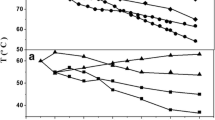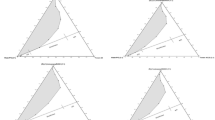Abstract
Microemulsion polymerization is widely used as a cleaner alternative way to prepare intrinsically conductive polymers. We studied isothermal phase diagrams for microemulsions of the electropolymerizable heterocyclic aromatic oil 3,4-ethylenedioxythiophene (EDOT), aqueous LiClO4 solution and alkyl polyethoxylate. Our specific goal was to assess the effect of LiClO4 salt on the phase behaviour. The phase behaviour was characterized by stepwise titration and microscopic analyses. Here we found that the increase of the concentration of LiClO4 salt shifts the microemulsion region to lower surfactant content.



Similar content being viewed by others
References
Bonkhoff K, Schwuger MJ, Subklew G (1997) Use of microemulsions for the extraction of contaminated solids. In: Solans C, Kunieda H (eds) Industrial applications of microemulsions. Surf Sci Ser, Chapt. 17, Marcel Dekker, New York, pp 66:355–374
Contractor AQ, Sureshkumar TN, Narayanan R, Sukeerthi S, Rakesh L, Srinivasa RS (1994) Conducting polymer-based biosensors. Electrochim Acta 39:1321–1324
Ferreira CA, Aeiyach S, Aaron JJ, Lacaz PC (1996) Electrosynthesis of strongly adherent polypyrrole coatings on iron and mild steel in aqueous media. Electrochim Acta 41:1801–1809
Haegel FH, Schluepen J, Schultze JW, Winkels S, Stromberg C (2001) Anodic polymerization of thiophene derivatives from microemulsions and liquid crystals. Electrochim Acta 46:3973–3894
Jonas F, Heywang G (1994) Technical applications for conductive polymers. Electrochim Acta 39:1345–1347
Kahlweit M, Strey R, Haase D, Firman P (1988) Properties of the three-phase bodies of H2O-oil-nonionic amphiphile mixtures. Langmuir 4:785–790
Kahlweit M, Strey R, Schomaecker R (1989) Microemulsion as liquid media for chemical reactions. In: Knoche W, Schomaecker R (eds) Reactions in compartmentalized liquids. Springer, Berlin Heidelberg New York
Roncali J (1992) Conjugated poly(thiophenes): Synthesis, functionalization, and applications. Chem Rev 92:711–738
Acknowledgements
This work was supported by Institut fuer Chemie und Dynamik der Geosphaere (ICG), Institut V: Sedimentaere Systeme, Forschungszentrum Juelich, D-52425 Juelich, Germany. The authors thank Dr. J. Schluepen for suggestions. The work is financed too by the Ministry of Science, Technology and Development of the Republic of Serbia (Project: 1727)
Author information
Authors and Affiliations
Corresponding author
Rights and permissions
About this article
Cite this article
Ilic, M., Haegel, FH., Zlatanovic, S. et al. Microemulsion with aromatic oil as cleaner media for electropolymerisation. Environ Chem Lett 3, 82–85 (2005). https://doi.org/10.1007/s10311-005-0101-3
Received:
Accepted:
Published:
Issue Date:
DOI: https://doi.org/10.1007/s10311-005-0101-3




